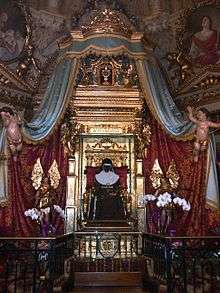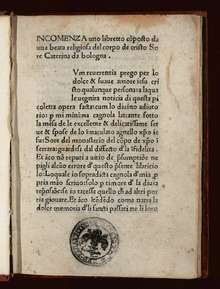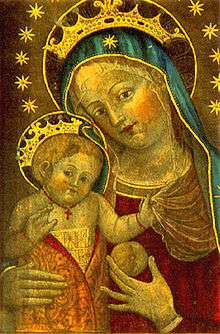Catherine of Bologna
| Saint Catherine of Bologna O.S.C. | |
|---|---|
 | |
| Religious; Virgin | |
| Born |
8 September 1413 Bologna, Italy |
| Died |
9 March 1463 (aged 49) Bologna, Italy |
| Venerated in | Roman Catholic Church |
| Beatified | 1524, Old Saint Peter's Basilica, Papal States by Pope Clement VII |
| Canonized | 22 May 1712, Saint Peter's Basilica, Papal States by Pope Clement XI |
| Feast | 9 March |
| Attributes | Religious habit |
| Patronage |
|
Saint Catherine of Bologna [Caterina de' Vigri] (8 September 1413 – 9 March 1463) was an Italian Poor Clare nun, writer, teacher, mystic, artist and saint.
The patron saint of artists and against temptations, Catherine de' Vigri was venerated for nearly three centuries in her native Bologna before being formally canonized, in 1712. Her feast day is 9 March.
Life
Catherine came from an upper class family, the daughter of Benvenuta Mammolini of Bologna and Giovanni Vigri, a Ferrarese notary who worked for Niccolò III d'Este, Marquis of Ferrara.[1] She was raised at Niccolo III's court as a lady-in-waiting to his wife Parisina d'Este (d. 1425) and became lifelong friends with his natural daughter Margherita d’Este (d. 1478).[2] During this time, she received some education in reading, writing, music, playing the viola, and had access to illuminated manuscripts in the d'Este Court library. [3]
In 1426, after Niccolo III's execution of Parisina d'Este for infidelity, Caterina left court and joined a lay community of beguines living a semi-religious life and following the Augustinian rule. The women were divided over whether instead to adhere to the Franciscan rule, which eventually happened.[4] In 1431 the beguine house was converted into the Observant Poor Clare convent of Corpus Domini, which grew from 12 women in 1431 to 144 women by the end of the century. [5] Sister Caterina lived at Corpus Domini, Ferrara most of her life from 1431 to 1456, serving as Mistress of Novices. She was a model of piety and experienced miracles and several visions of Christ, the Virgin Mary, Thomas Becket and St. Joseph, as well as future events, such as the fall of Constantinople in 1453. She wrote a number of religious treatises, lauds, sermons, and copied and illustrated her own breviary (see below).
In 1455 the Franciscans and the governors of Bologna requested that she become abbess of a new convent, which was to be established under the name of Corpus Domini in Bologna. She left Ferrara in July 1456 with 12 sisters to start the new community, and remained abbess there until her death on 9 March 1463. Caterina was buried in the convent graveyard, but after eighteen days, a sweet smell emanated from the grave and the incorrupt body was exhumed. It was eventually relocated to a chapel where it remains on display, dressed in her religious habit, seated upright behind glass. A contemporary Poor Clare, Sister Illuminata Bembo, wrote her biography in 1469.[6] A strong local Bolognese cult of Caterina Vigri developed and she became a Beata in the 1520s, but was not canonized until 1712.
Literary Works
Catherine’s best known text is Seven Spiritual Weapons Necessary for Spiritual Warfare (Le Sette Armi Spirituali), which she appears to have first written in 1438, and then rewritten and augmented between 1450 and 1456. Although she probably taught similar ideas, she kept the written version hidden until she neared death, and then handed it to her confessor with instructions to send a copy to the Poor Clares at Ferrara. Part of this book describes at length her visions both of God and of Satan.[7] The treatise was circulated in manuscript form through a network of Poor Clare convents. The Sette Armi Spirituali became an important part of the campaign for her canonization. It was first printed in 1475, and went through 21 later editions in the sixteenth and seventeenth centuries, including being translated in Latin, French, Portuguese, English, Spanish, and German. It therefore played an important role in the dissemination of late medieval vernacular mysticism in the early modern period. In addition, she wrote lauds, short religious treatises and letters, [8] as well as a 5000-line Latin poem called the Rosarium Metricum [9], the I Dodici Giardini and I Sermoni.[10].These were discovered around 2000 and described by Cardinal Giacomo Biffi: as "now revealed in their surprising beauty. We can ascertain that she was not undeserving of her renown as a highly cultivated person. We are now in a position to meditate on a veritable monument of theology which, after the Treatise on the Seven Spiritual Weapons, is made up of distinct and autonomous parts: The Twelve Gardens, a mystical work of her youth, Rosarium, a Latin poem on the life of Jesus, and The Sermons, copies of Catherine's words to her religious sisters."
Artistic Works
Vigri represents the rare phenomenon of a fifteenth-century nun-artist whose artworks are preserved in her personal breviary. [11] She meditated while she copied the scriptural text, adding about 1000 prayer rubrics, and drew initials with bust-portraits of saints, paying special attention to images of Saints Clare and Francis.[12] Besides multiple images of Christ and the infant swaddled Christ Child, she depicted other saints, including Thomas Becket, Jerome, Paul, Anthony of Padua, Mary Magdalene, her name saint Catherine of Alexandria. Her self-taught style incorporated motifs from needlework and devotional prints. Some saints' images, interwoven with text and rubrics, display an idiosyncratic, inventive iconography also found in German nuns' artworks (nönnenarbeiten). [13] The breviary and its images surely served a didactic function within the convent community. [14] Other panel paintings and manuscripts attributed to her include the "Madonna and Child" (nicknamed the Madonna del Pomo) in the Cappella della Santa, a possible portrait or self-portrait (?) in the autograph copy of the Sette Armi Spirituali, a Redeemer, and another Madonna and Child in her chapel. [15] Recently scholars have rejected these artworks either based on style or scientific examination of materials, and called her reputation as a painter "more legendary than fact."[16]

A drawing of a Man of Sorrows or Resurrected Christ found in a miscellany of lauds (Ms. 35 no.4, Archivio Generale Arcivescovile, Bologna) has also been attributed to her. Vigri is significant as a woman artist who articulated an aesthetic philosophy. She explained that although it took precious time, the purpose of her religious art was "to increase devotion for herself and others". [17]

References
- ↑ Dunbar, Agnes B.C. (1904). A Dictionary of Saintly Woman. George Bell & Sons. p. 160.
- ↑ Arthur, Kathleen G. (2005) "Il breviario di Santa Caterina da Bologna e 'l'arte povera' clarissa," I Monasteri femminili come Centri di Cultura fra Rinascimento e Barocco, ed. G. Pomata & G. Zarri, pp. 93-122.
- ↑ Arthur, Kathleen G. (2018) Women, Art and Observant Franciscan Piety, (Amsterdam: Amsterdam Univ Press), pp. 71-76
- ↑ Mc Laughlin, Mary Martin (1989). "Creating and Recreating Communities of Women: The Case of Corpus Domini, Ferrara, 1406-1452". Signs. 14 (2): 313. doi:10.1086/494511. JSTOR 3174552.
- ↑ Lombardi, P. Teodosio (1975). I Francescani a Ferrara, IV (Bologna: Dehone), pp. 63-277.
- ↑ Bembo, ed. Silvia Mostaccio (2001) Specchio di Illuminazione,(Florence: SISMEL).
- ↑ "CATHOLIC ENCYCLOPEDIA: St. Catherine of Bologna". www.newadvent.org.
- ↑ Vigri, ed. Serventi, Silvia (2006) Caterina Vigri, Laudi, Trattati e Lettere, (Florence: SISMEL)
- ↑ Vigri, ed. Sgarbi, Gilberto (1997). Rosarium Metricum. Poema del XV Secolo (Bologna: Giorgio Barghigiani).
- ↑ Vigri, ed. Sgarbi, Gilberto (1999), I Sermoni (Bologna: Giorgio Barghigiani).
- ↑ Fortunati, Vera & C. Leonardi. (2004). Pregare con le Immagini, (Florence, SISMEL).
- ↑ Arthur, Kathleen G. (2004). "Images of Clare and Francis in Caterina Vigri's Personal Breviary,"Franciscan Studies 62, pp. 177-192.
- ↑ Arthur (2018), Women, Art and Observant Franciscan Piety, pp. 86-118.
- ↑ Faberi, Mariafiamma (2013). "La Pedagogia dell'immagine nelle miniature e negli scritti di S. Caterina Vigri," Dalla Corte al Chiostro eds. Clarisse di Ferrara, P. Messa, F. Sedda (Assisi: Edizioni Porziuncola), pp. 177-200.
- ↑ Wood, Jeryldene M. (1996). Women, Art, and Spirituality. The Poor Clares of Early Modern Italy, (Cambridge: Cambridge University Press), pp. 121-144, 196-197.
- ↑ Biancani, Stefania (2002). "La leggenda della monaca artista: Caterina Vigri", Vita artistica nel monastero femminile. exempla. ed. V. Fortunati (Bologna: Editrice Compositore), pp. 203-219.
- ↑ Arthur (2018), Women, Art and Observant Franciscan Piety, pp. 86-118.
Further reading
- Arthur, Kathleen G. Women, Art and Observant Franciscan Piety. Caterina Vigri and the Poor Clares in Early Modern Ferrara, Amsterdam: Amsterdam University Press, 2018. ISBN 978-94-6298-4332
- Arthur, Kathleen G. "Images of Clare and Francis in Caterina Vigri's Personal Breviary, "Franciscan Studies 62, 2004, pp. 177-192.
- Arthur, Kathleen G. "Il breviario di Santa Caterina da Bologna e 'l'arte povera' clarissa," I Monasteri femminili come Centri di Cultura fra Rinascimento e Barocco, ed. G. Pomata & G. Zarri, 2005, pp. 93-122.
- Babler, Ernst Z., Katharina (Vigri) von Bologna (1413-1463), Leben un Schriften, Fachstelle Franzikanishe Forschung, Munster, 2012 ISBN 978-3-8482-1026-8
- Bartoli, Marco. Caterina, la Santa di Bologna, Bologna: Ed. Dehone, 2003.
- Bembo, Illuminata. Specchio di Illuminazione, Vita di S. Caterina a Bologna, 1469, ed. Silvia Mostaccio, Florence: SISMEL, 2001.
- Chadwick, Whitney. Women, Art and Society, London: Thames and Hudson, 1994 ISBN 978-0-500-20393-4
- Evangelisti, Silvia. Nuns: a history of convent life, 1450-1700. Oxford University Press, 2007.
- Fortunati, Vera & Claudio Leonardi (eds.): Pregare con le Immagini, Il breviario di Caterina Vigri, Ed. del Galluzzo, Ed. Compositori, 2004.
- Fortunati, Vera, Jordano Pomeroy & Claudio Strinati, Italian Women Artists from Renaissance to Baroque, National Museum of Women in the Arts, Washington, D. C., 2009.
- Guerro, P. Angel Rodriguez, Vita di Santa Caterina da Bologna. Bologna, 1996.
- Harris, Anne Sutherland and Linda Nochlin, Women Artists: 1550–1950, Los Angeles County Museum of Art, Knopf, New York, 1976 ISBN 978-0-87587-073-1
- Morina, Giulio.Vita della Beata Caterina da Bologna. Descritta in pittura, Ed. Pazzini, 2002
- Pomata, Gianna. "Malpighi and the holy body: medical experts and miraculous evidence in seventeenth-century Italy," Renaissance Studies 21, no. 4 (2007): 568-586.
- Ricciardi, Renzo. Santa Caterina da Bologna, Ed. Tipografia del Commercio, Bologna 1979.
- Rubbi, Paola.Una Santa, una Città, Caterina Vigri, co-patrona di Bologna, Ed. del Galluzzo 2004.
- Serventi, Silvia. Caterina Vigri, Laudi, Trattati e Lettere, (Florence: SISMEL, 2000).
- Spanò Martinelli, Serena. Il processo di canonizzazione di Caterina Vigri, 2003.
- Santa Caterina da Bologna. Dalla Corte Estense alla Corte Celeste, Bologna, Ed. Barghigiani, 2001.
- Caterina Vigri, la Santa e la Città, Atti del Convegno, Bologna, 13-15 novembre 2002, Ed. Galluzzo 2004.
- Caterina Vigri, The Seven Spiritual Weapons, translated by Hugh Feiss & Daniela Re, Toronto, 1998.
External links
| Wikimedia Commons has media related to Catherine of Bologna. |